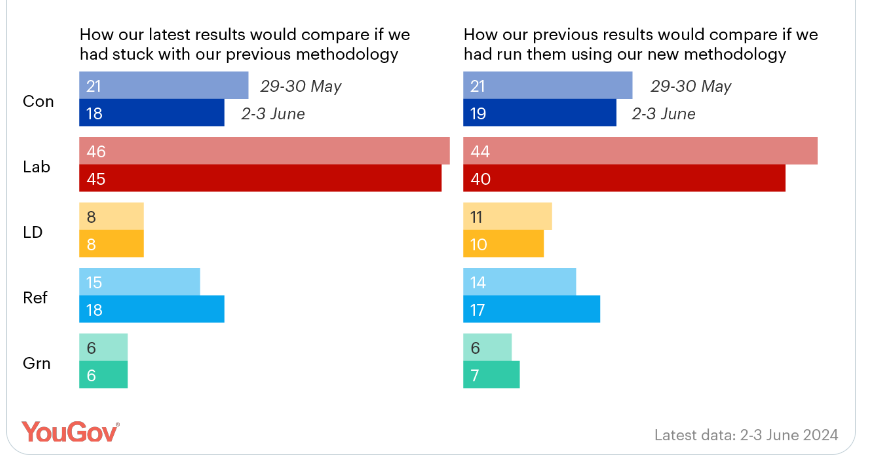A year ago I wrote a post setting out the five necessary conditions for a Tory wipeout (now widely known as the Canada ‘93 scenario). Four of the conditions were already in place before the campaign started:
As Dylan showed on Tuesday the Tory position on key issues is as bad as ever for a governing party going into an election.
As he also showed Sunak’s ratings are the worst of any party leader going into an election.
As Josh explained last week the Labour vote has become far more “efficient”.
We can see high levels of intention to vote tactically and Labour/Lib Dems are far more aligned than at any point since 2001.
The fifth condition was the rise of Reform, and particularly the return of Farage. Back when I wrote that piece they were polling at 6%. A real wipeout result needed a split on the right.
Well yesterday we had a YouGov poll that put Reform on 17%, just 2 points behind the Conservatives. Had YouGov not just changed their methodology the parties would have been equal on 18 points.
It’s one poll, so let’s see if others back it up. But I did say, on Tuesday, that I thought Farage’s return would do something like this, and it’s put the Tories in a more perilous position than they’ve been in their history.
All of which makes it quite hard to make seat predictions right now. We’re in unprecedented territory. While the Conservatives could recover somewhat to 150 or even 200 seats, almost none of the ones they hold are safe.
Nevertheless, I am going to persist with my plan to do seat-by-seat previews, while flagging that the predictions are very much “draft” as we see how this plays out.
I appreciate that, even for me, previewing all 650 seats might seem a tad obsessive but there are, I think, three good reason to do so and which will hopefully make it interesting for subscribers.
There are far more competitive seats than normal because of such dramatic poll movements in both England and Scotland. Around 400 seats could change hands. The canvas of this election is much bigger than usual.
A lot of seats have changed boundaries or are completely new this election. It’s helpful to see how the political geography has changed and how that might affect tactical voting.
Perhaps most importantly, it’s a good opportunity to take a look at the people who make up our next Parliament. It’s entirely possible that the majority of MPs will be new. Something that has only happened once, in 1945. I will be writing overviews of what the post-election parties will look like later in the campaign but that requires going seat by seat.
Also it’s just fun. Anyway we’re going to start in the South East, with 24 seats in three counties that have always been very Conservative, even in 1997, but probably won’t be this time: Buckinghamshire, Berkshire and Oxfordshire. I’ll put running scores at the bottom after every batch so it builds into a full prediction by the end.
(An important caveat, majority figures are taken from the Thrasher and Rallings notionals. For seats with boundary changes these are estimates and will sometimes be a bit out, especially for new seats with big changes. A number of local campaign teams have told me they think the figures are suspect. That introduces an element of extra difficulty to predictions.)
Keep reading with a 7-day free trial
Subscribe to Comment is Freed to keep reading this post and get 7 days of free access to the full post archives.




